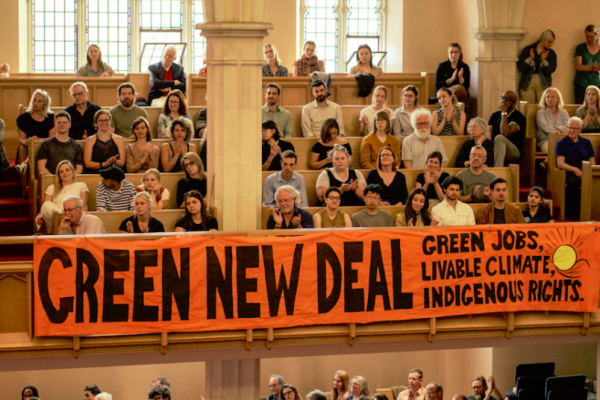The false hope of carbon capture and storage
We can’t allow oil companies to leverage carbon removal as their latest scheme to profit from the climate crisis

A carbon capture plant built by Climateworks in Hinwil, Switzerland. Photo by Adam Sébire/Keystone/Redux.
Carbon Engineering, the carbon removal start-up based in Squamish, BC’s “Outdoor Recreation Capital,” recently announced an exciting new use of their direct air capture (DAC) technology by one of their partners in the US. The partner, 1PointFive, sold 400,000 tonnes of “carbon removal credits” to the aircraft manufacturer Airbus, putting to rest once and for all the argument by naysayers that direct air capture will never be “feasible, affordable, and scalable.”
Let’s take a closer look.
To start off, who is behind 1PointFive? It turns out it was founded in 2020, a year after plans for this DAC facility were first announced by Occidental Petroleum, which owns 1PointFive, and Carbon Engineering. Carbon Engineering is also partially owned by Occidental—along with Chevron and other investors. This DAC facility is an Occidental Petroleum project.
That’s fine. Maybe one oil company is finally turning the corner on climate? Well, in 2019, when the facility was announced, the project was intended to produce a form of carbon dioxide that would be used by Occidental for a process called “enhanced oil recovery.” Basically, they would inject the captured carbon dioxide into the ground in order to extract more oil. Their press releases spoke of enhanced oil recovery and “geological sequestration” in the same paragraph, suggesting that they considered enhanced oil recovery a mechanism for “permanent sequestration” of carbon.
It’s not clear to what degree that plan has changed today and 1PointFive has not responded to inquiries (mine or others). The project rebrand has seemingly meticulously avoided mentioning enhanced oil recovery, but so far they have announced only one vague plan with no timeline for sequestering carbon underground in a place that isn’t an active oil and gas operation.
Using captured carbon dioxide to extract more oil is problematic in a couple ways: first, it makes oil extraction cheaper, driving the price of oil down and the total consumption of oil up. Second, it creates a new public subsidy for the already heavily subsidized oil industry as the company soaks up tax credits that are used to help it extract more oil. This kind of use of DAC technology does nothing but buy social license for continued expansion of the fossil fuel industry.
Let’s say, though, that they really do intend to permanently sequester carbon without using it to pump up their petrochemical business model. Great!
400,000 tonnes of carbon removal sounds like a lot. A million tonnes—the annual capacity of the proposed DAC plant—sounds like even more. But according to Airbus’s website, the 566 commercial aircraft they delivered in 2020 will generate 440 million tonnes of carbon dioxide equivalent over their (average) 22 year service lives. Airbus has delivered about 2,000 aircraft in the last three years.
Once operating, the proposed DAC plant would offset roughly 1.3 percent of the annual emissions associated with those 2,000 planes. There were 22,000 private jets operating in 2019 and many more commercial ones. Boeing, another aircraft manufacturer, believes that there will be a market for 40,000 new planes just over the next two decades.
“OK, OK,” you might say. “It’s just a proof of concept! Wider deployment will follow.” Well, it’s hard to imagine that there’s space (or funding) for tens of thousands of these plants to be built, let alone for the carbon they capture to be safely and permanently sequestered. But assuming there is, the announcement obscures a more fundamental issue: it’s not actually a proof of concept.
The carbon removal plant doesn’t exist yet. Instead, this deal is nothing more than proof that oil companies and private equity firms can profit from the creation of a new financial product. 1PointFive’s announcement heralded the sale of 400,000 speculative financial units: carbon removal futures. A burgeoning carbon market of this kind may help inflate GDP and public perceptions of climate progress, but it won’t actually remove any carbon from the atmosphere.
And, while failing to reduce atmospheric carbon, this narrative—the idea that the carbon removal market is taking off—helps perpetuate fossil fuel use. 1PointFive and Carbon Engineering advertise their business as a way to “address emissions from hard-to-decarbonize industries” like aviation. Aviation is indeed “hard-to-decarbonize”—though I’m personally hopeful about Kim Stanley Robinson’s dreams of resurrecting blimp travel—but it is also almost exclusively a luxury practice. Huge numbers of people have never flown; the vast majority of people fly rarely. Only the world’s top emitters fly with any regularity: the wealthiest one percent generate 50 percent of all aviation emissions.
By classifying air travel as a “hard-to-decarbonize” industry that must be addressed through offsetting and carbon removal, the oil and aviation industries are successfully precluding discussion of the far simpler and more effective alternative: drawing down this wasteful luxury practice. Then, by spinning the story that carbon removal is a rapidly growing market, they reassure the public that we are well on our way to offsetting “hard-to-decarbonize” industries and shrinking them would be an unnecessary sacrifice called for only by radical environmentalists.
Carbon Engineering also entrenches fossil fuel use by another, more direct route: they have created a process called AIR TO FUELSTM that produces a liquid fuel from atmospheric carbon that can be burned in existing vehicles. The BC government, along with Occidental Petroleum, is funding the development of the first commercial scale facility that will produce “up to 100 million litres of fuel each year.”
This seems sort of promising on face, but it allows the government and others to punt on real climate action (replacing internal combustion engine vehicles with electrified public transit, drawing down aviation, and transitioning buildings away from fossils) by claiming that they are making progress on these so-called “ultra-low carbon” fuels. And the BC government does exactly that despite the fact that this plant—if it ever becomes operational—would only produce enough fuel to power less than two percent of consumer vehicle use in the province each year.
The press releases, the government investment, the statements by politicians: these all communicate that it’s okay to keep doing what we’re doing because we’re investing in new technologies to solve climate change, a tale that is wildly misleading and dangerous.
The climate scientist David Ho likes to put these negative emissions projects in perspective through a time machine frame: how far back can we go by deploying this carbon removal operation? For Occidental’s Permian Basin plant, if it ever opens, that answer is 13 minutes and 30 seconds. There are 525,960 minutes in a year. And global emissions are still rising.
Do we need carbon removal? Almost certainly, but not because we need to offset “hard-to-decarbonize” industries: we need it because we’ve already disrupted the climate to dangerous levels. Just ask any of the billion people who just endured a 50 degree heatwave on the Indian subcontinent. But the far higher priority is immediate and rapid decarbonization and an end to fossil fuel expansion.
Carbon Engineering and its DAC technologies make it abundantly clear that private investment in carbon removal is subject to moral hazard. We cannot allow oil companies to leverage carbon removal as their latest scheme to perpetuate and profit from the climate crisis. And while well-regulated carbon markets may have a place in effective climate action, we have to be wary of financialization: buying and selling imaginary carbon credits gets us nowhere.
Activists often point to the Paris Agreement as a success because of its establishment of 1.5C as a target, but a close reading of it elucidates how we got to the position we’re in today where the exciting developments in climate seem to be dominated by the invention of new financial assets and little else. As the author Amitav Ghosh put it, “[the Agreement’s] intention, and the essence of what it has achieved, is to create yet another neo-liberal frontier where corporations, entrepreneurs, and public officials will be able to join forces in enriching each other.”
We are living in the Paris Agreement’s world, a world where its nominal target has become unachievable but where global decision-makers and businesses are constantly finding new, innovative ways to profit from exacerbating the climate crisis. We’ve seen what happens with massive influxes of capital into speculative financial products all too many times before. This time, our entire planet is on the line.
Nick Gottlieb is a climate writer based in Squamish, BC and the author of the newsletter Sacred Headwaters. His work focuses on understanding the power dynamics driving today’s interrelated crises and exploring how they can be overcome. Follow him on Twitter @ngottliebphoto.










